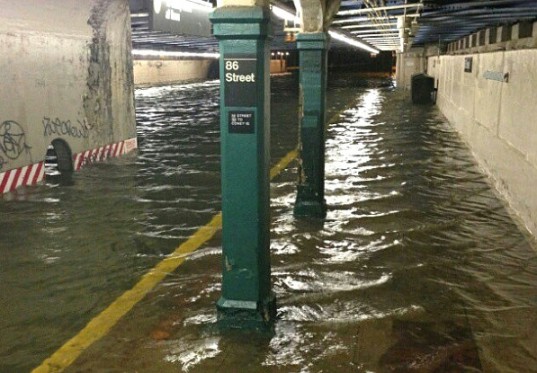Almost five years ago, New York City, along with many surrounding towns and states, was devastated by a storm more dangerous than anything we’d ever seen to date in this area. Fueled by worsening climate change and rising global temperatures, Superstorm Sandy took the lives of 43 New Yorkers.
New York’s subway systems flooded, homes were destroyed, and hundreds of thousands lost power. By the time Sandy passed, it had left tens of thousands of families homeless and had cost New Yorkers $42 billion in damage, which communities are still paying for today. The worst damage was borne by New York City’s most vulnerable: people of color, low-income people, and the elderly.

Extreme weather conditions are only getting worse. In the past few months, we have seen Hurricane Harvey tear through Texas and Louisiana with unprecedented rainfall and flooding, and Hurricane Irma, the strongest storm ever recorded in the Atlantic, devastated Florida and the Caribbean.
Hurricane Maria essentially leveled large areas of Puerto Rico leaving millions without power and causing unprecedented damage with significant political repercussions. New Yorkers, many who have family and friends in Puerto Rico, have leapt forward to help.
Climate disasters threaten communities around the world and with an United States federal government bought and paid for by fossil fuel billionaires, people are rightfully afraid. But we are also determined.
New York, as one of the financial centres of the world, and often looked to for political leadership both inside and outside the United States, should be a model for a climate action. But it can’t lead if it refuses to clean up its own house. New York city and state pensions, amongst the largest in the world, should not be invested (to the tune of over $15 billion!) in destructive oil, gas and pipeline companies. The city and state should be powered by clean energy not dirty fossil fuels and must stop building new fossil fuel projects like fracked gas pipelines. Neighborhoods and housing damaged by Sandy must be rebuilt and made more energy efficient. And New York politicians need to stand up to President Trump and his climate denial for the good of New Yorkers and the world.
Five years after Sandy, we are rising. On Saturday, October 28th, thousands of New Yorkers will assemble and march over the iconic Brooklyn Bridge – a rising wave of hope – and then rally at the Smith Houses, a community heavily affected by Superstorm Sandy.
In recent weeks New Yorkers have been speaking up, sharing their stories about why they are marching on October 28th. They want to live in a city where we can all breathe clean air, where our economy is powered by good jobs and renewable energy, and where our families are safe from dangerous floods and heat waves.
Yexenia is a New Yorker who lost everything after Superstorm Sandy. Take three minutes to watch Yexenia’s story, and RSVP now for the Sandy5 march on October 28th: sandy5.org
Posted by Fossil Free on Monday, 16 October 2017
Together, we are going to fight for this vision. While we are coming together to remember lives lost and the damage incurred from Sandy, we will do more than remember. We will demand climate action from New York City Mayor Bill de Blasio, New York State Governor Andrew Cuomo, and Federal Senator Chuck Schumer.
New York’s elected officials need to show they’re serious about climate change. They need to do their part to ensure that New York is an inspiring example of real climate action for other cities and towns across the United States and around the world.
Join us as We Remember. We Resist. We Rise. – RSVP at Sandy5.org
Can’t be in NYC? Spread the word via Twitter and Facebook
Devastated by Hurricanes Sandy and Maria: It’s time for action https://t.co/CRcRP3OPY1
Join #Sandy5 March on Oct 28 in NYC. pic.twitter.com/YQIEJ3DfMl
— 350 dot org (@350) October 13, 2017